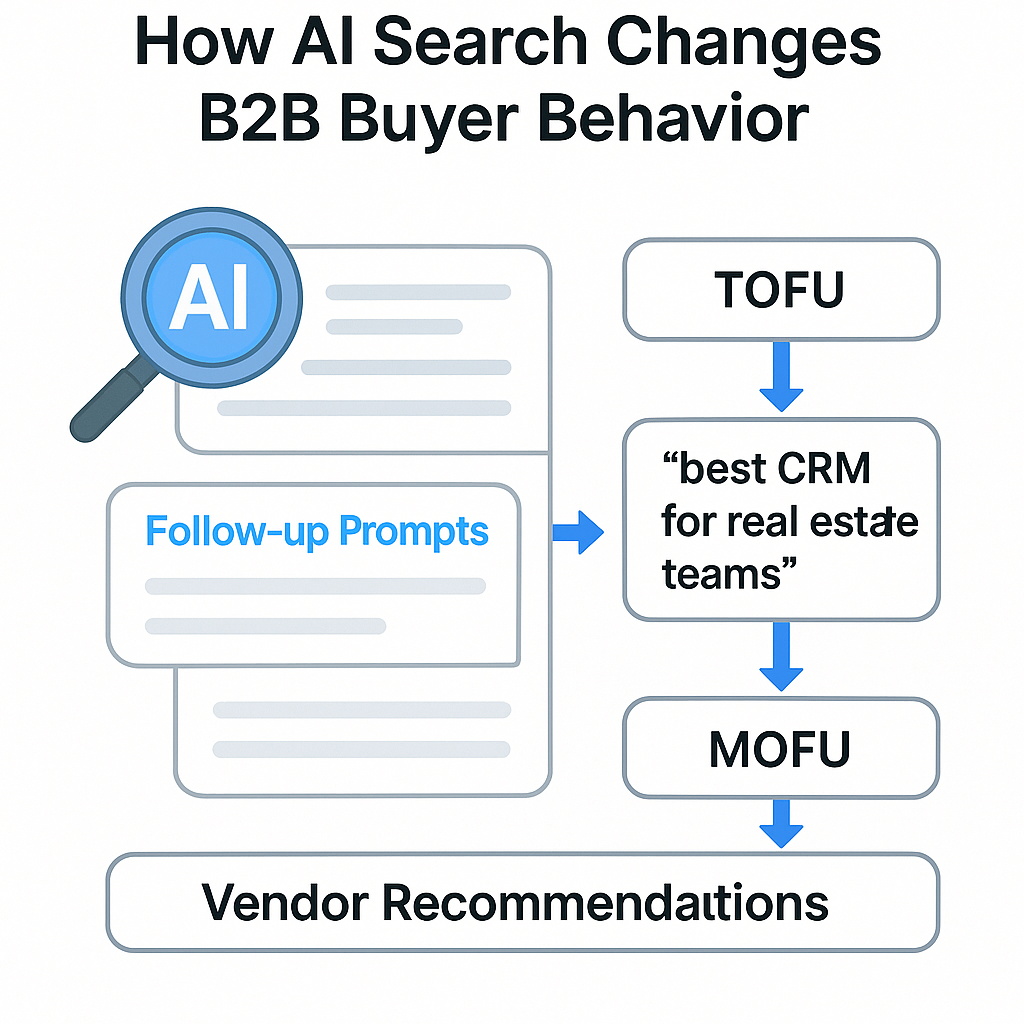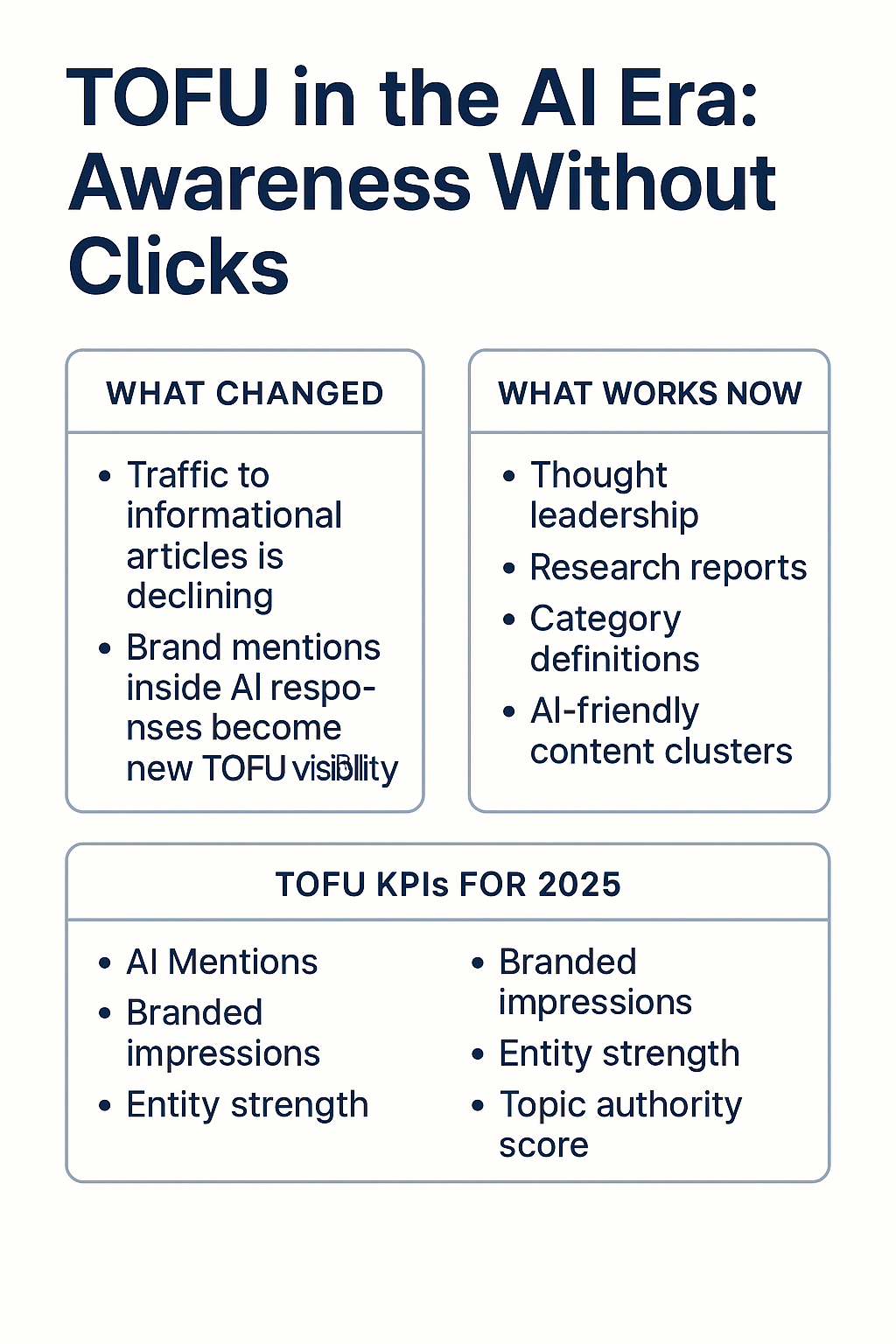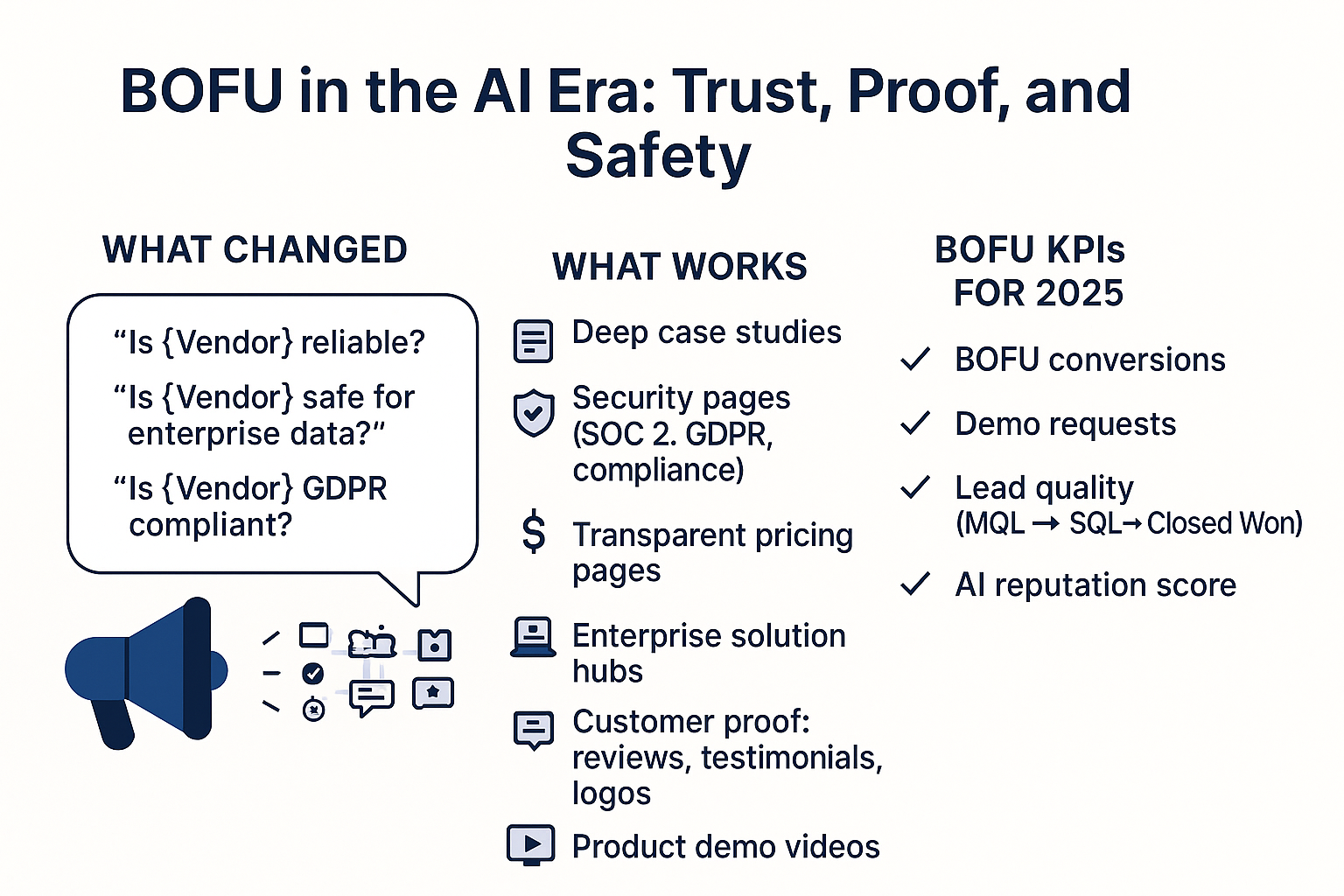November 21, 2025
Semantic Blocks: The New Structure of AI-Optimized Content
November 20, 2025
Multimodal SEO: How AI Uses Images, Video & Diagrams to Rank Pages
November 19, 2025
Author:
.png)
The traditional TOFU–MOFU–BOFU funnel was built for a world where buyers moved step-by-step through search results, blog posts, comparison pages, and vendor sites. But in 2025, this linear journey no longer reflects how B2B decision-makers actually behave.
AI search has reorganized the entire buying process. Instead of navigating through multiple SERPs, buyers now start their research directly inside platforms like SearchGPT, Bing Copilot, and Perplexity, where they receive synthesized, expert-style answers instantly. They skip the “information exploration phase” because AI does it for them.
The shift is dramatic:
AI flattened the funnel — but made intent deeper.
Buyers still go through awareness, evaluation, and decision stages, but they no longer follow them in order. They jump between them based on the quality of AI-generated insights in front of them. And this change is rewriting the rules of B2B SEO.
AI search engines fundamentally changed how B2B buyers discover and evaluate vendors. Instead of scrolling through traditional listings, users now get immediate, fully structured answers that merge insights from hundreds of sources into a single, actionable summary.
And they don’t stop there — Large Language Models guide the buyer with follow-up prompts, pushing them deeper into the funnel:
This means a buyer can jump from TOFU → MOFU in one interaction, sometimes within a single query like:
“best CRM for real estate teams”.
What traditionally took 3–5 searches now happens instantly inside an AI response.
Another major shift: vendor recommendations are now embedded directly into AI answers. If a brand is recognized as an authoritative entity, SearchGPT or Perplexity may list it as a top solution — bypassing the need for the user to visit multiple websites.
This new buying behavior compresses the path to purchase, but increases the importance of being cited by AI as a trustworthy, contextually relevant vendor.

AI fundamentally reshapes top-of-funnel visibility. Traditional informational traffic — the backbone of TOFU for over a decade — is no longer the main entry point for B2B buyers. Because AI search engines now generate instant summaries, users often get answers without needing to click anything at all.
AI has essentially replaced “blog visits” with “brand presence inside answers.”
Modern TOFU is about authority and structured clarity, not just keyword volume:
These formats feed AI models directly and dramatically increase the likelihood of being cited.
TOFU is no longer about chasing pageviews — it’s about dominating the knowledge layer that AI pulls from.
Mid-funnel behavior has undergone the biggest transformation of all. In the past, buyers evaluated multiple vendors by manually opening comparison articles, reading case studies, and navigating between websites. In 2025, MOFU happens directly inside LLMs.
Buyers now ask AI engines questions like:
SearchGPT or Perplexity automatically compare vendors using:
The evaluation stage — previously driven by dozens of clicks — is now fully AI-mediated.
A buyer can complete an entire MOFU sequence without ever touching your site.
Visibility during MOFU now depends on whether the AI model recognizes your brand as a relevant, trustworthy option.
To influence these AI-driven comparisons, B2B brands must provide structured, high-authority content:
The more structured and entity-rich your content is, the more likely AI is to surface your brand as an option.
In 2025, dominating MOFU means being present everywhere AI pulls data from — not just ranking on Google.

Bottom-of-funnel behavior has changed more radically than any other stage.
When buyers reach the decision phase, they no longer visit 5–10 vendor pages to check trust signals manually — they ask AI directly.
Buyers now ask SearchGPT, Bing Copilot, or Perplexity questions like:
Instead of scanning security pages, review sites, and pricing tables, the AI model surfaces the relevant information instantly.
This means:
AI will not recommend a vendor unless their entity, compliance, and authority signals are strong, consistent, and well-documented across the web.
To win BOFU in 2025, B2B brands must maximize trust signals that AI can reliably retrieve and cite:
The more structured, transparent, and credible your content is, the more confidently AI will recommend your product in BOFU requests.
BOFU today is all about trust. Without strong trust assets, AI will simply recommend someone else.
Traditional B2B funnels assumed a linear journey:
TOFU → MOFU → BOFU
But AI search broke this structure.
AI compresses stages, because it gives buyers answers, comparisons, risks, and recommendations instantly. As a result:
Example:
A person who types “best SOC 2 compliance tools” is already MOFU/BOFU — even if they never entered the TOFU stage at all.
Instead of a vertical funnel, B2B search in 2025 looks like:
┌──────────────┐
│ Intent Layer│ (broad informational)
├──────────────┤
│ Intent Layer│ (evaluation, comparisons)
├──────────────┤
│ Intent Layer│ (trust, proof, compliance)
└──────────────┘
Buyers “jump” directly into the layer matching their intent — guided by AI.
This is why SEO strategies built only on TOFU blog posts are now collapsing: AI routes most qualified buyers straight into evaluation and decision layers.

To win in a world where LLMs drive discovery and decision-making, B2B SEO requires a new framework — one built on intent, entity strength, and AI visibility.
Trends, benchmark reports, definitions, and expert insights help AI models recognize your brand as an authority.
Your brand must appear in AI-generated comparisons.
That requires structured data, alternatives pages, and industry use cases.
Security assurances, transparent pricing, customer stories, and trust signals influence whether AI recommends you as a reliable vendor.
Consistent descriptions, structured data, glossary pages, datasets, and unified brand identity increase your presence across AI systems.
New KPIs matter more now:
AI Mentions, inclusion in comparisons, brand sentiment, entity confidence, demo requests.
AI search introduced an entirely new measurement layer for B2B SEO.
Traditional metrics like clicks, impressions, and average position still matter — but they no longer show the full picture. In 2025, leading B2B brands evaluate how AI systems perceive and recommend them, not just how Google ranks them.
How often your brand appears inside AI-generated answers.
This is the new version of “impressions” in the LLM era.
Whether your product shows up in “Top X Tools,” “Best Platforms for…,” or “Alternatives to…” lists generated by AI models.
If you’re missing — AI is recommending your competitors instead.
A rise in branded searches reflects stronger trust and higher awareness driven by AI recommendations.
Visitors who arrive after interacting with AI tend to scroll deeper and consume more content — a sign of higher intent.
AI-qualified leads move through the funnel faster.
Tracking velocity shows how well AI is warming up mid-funnel prospects.
AI often influences the decision without generating a direct click.
Multi-touch attribution becomes essential.
How frequently AI suggests your brand when users ask for vendors.
This becomes a core KPI for entity authority and AI-driven trust.
These new metrics define the B2B SEO landscape in 2025.
Without them, you can’t understand your true funnel performance.
Even in 2025, many B2B brands apply outdated SEO logic — and unintentionally make themselves invisible to AI systems and high-intent buyers.
Informational blogs no longer drive reliable traffic.
AI summaries replace clicks.
If your site doesn’t have these pages, SearchGPT fills the gap with competitor data.
AI always needs a list — and will use someone else’s if you don’t provide your own.
You can grow in Google while losing visibility inside AI-generated answers.
Most companies don’t track this — and it’s a massive blind spot.
AI models need clear structure: schema, datasets, feature tables, definitions.
Without structure, your product becomes invisible to the model.
Inconsistent naming, different descriptions, mismatched brand messaging.
To AI, this looks like multiple entities — and trust collapses.
These mistakes cause AI to recommend competitors, not because they’re better, but because they’re easier to understand.
AI search has rewritten the B2B funnel.
The buyer journey is no longer linear. Users don’t move through TOFU → MOFU → BOFU in sequence. They jump directly to the layer that matches their intent — often starting at MOFU or even BOFU with their very first query.
Winning in 2025 requires a fundamentally new approach:
The future of B2B SEO is a blend of entity building, structured data, AI-friendly content, and deep proof of value.
Brands that embrace this shift will control the new AI-driven funnel.
Your new AI assistant will handle monitoring, audits, and reports. Free up your team for strategy, not for manually digging through GA4 and GSC. Let us show you how to give your specialists 10+ hours back every week.
Read More

November 21, 2025
10 min

November 20, 2025
10 min

November 19, 2025
10 min
Just write your commands, and AI agents will do the work for you.